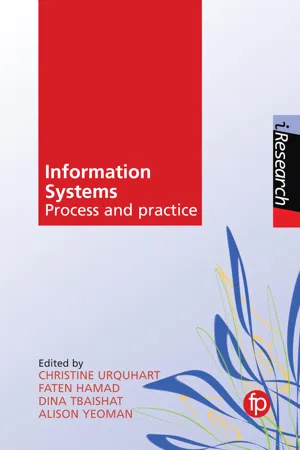
Information Systems
Process and practice
- 288 pages
- English
- PDF
- Available on iOS & Android
Information Systems
Process and practice
About this book
This book adopts a holistic interpretation of information architecture, to offer libraries and information professionals a variety of methods, tools, and techniques that may be used when designing websites and information systems that support workflows and what people require when "managing information".
The editors argue that information architecture for libraries has largely been the study of content architecture and that, on the other hand, library assessment literature has dealt with performance measurement and change management strategies. There is a gap in the middle for information services, with little on the ways of looking at the process architecture of a library and information service and on methods for business process analysis. Information Systems: Process and practice aims to fill that gap with a combination of theory and supporting case studies written by an international line-up of contributors, including Sally Burford, Fernando Loizides, Catherine Burns and Adam Euerby. Case studies cover a wide variety of settings, from discrete resource discovery projects for academic and cultural institutions, through design for large organizational websites, the research evidence about user experience for semi-structured document design on websites, to the health sector with examples including patient support websites and clinical document management.
This book:
- takes a holistic view and interpretation of Information architecture in the context of libraries across the sector, globally
- discusses research and methods that help libraries and information services work from strategic business objectives through the organisation of processes that support the information services offered, and information management functions supported
- opens a new area of research/investigation on the link between information behaviour research and information systems and architecture, supported by case studies and projects
- includes contributions from an international range of experts from diverse backgrounds
- uses introductory sections and chapter commentary from the editors to draw the discussions together.
This will be essential reading for researchers in information science specifically in the areas of digital libraries, information architecture and information systems. It will also be useful for practitioners and students in these areas who want to know the different research issues and challenges and learn how they have been handled in course of various research projects in these areas.
Frequently asked questions
- Essential is ideal for learners and professionals who enjoy exploring a wide range of subjects. Access the Essential Library with 800,000+ trusted titles and best-sellers across business, personal growth, and the humanities. Includes unlimited reading time and Standard Read Aloud voice.
- Complete: Perfect for advanced learners and researchers needing full, unrestricted access. Unlock 1.4M+ books across hundreds of subjects, including academic and specialized titles. The Complete Plan also includes advanced features like Premium Read Aloud and Research Assistant.
Please note we cannot support devices running on iOS 13 and Android 7 or earlier. Learn more about using the app.
Information
Table of contents
- Title page
- Contents
- CHAPTER 1: Introduction
- CHAPTER 2: Approaches to information architecture
- CHAPTER 3: Taxonomy testing for information architecture
- CHAPTER 4: The enterprise website and its information structures
- CHAPTER 5: Analysing activities, roles and processes
- CHAPTER 6: Libraries and the organisation of library processes – a history of operational research, and the use of process modelling
- CHAPTER 7: Using Riva process modelling to study book acquisition in academic libraries
- CHAPTER 8: Workflow analysis and process mapping in US academic libraries
- CHAPTER 9: A theoretical framework for designing and evaluating semi-structured document triage interfaces
- CHAPTER 10: Resource discovery case studies
- CHAPTER 11: Increasing social connection through a community-of-practice inspired design
- CHAPTER 12: Methods for studying information provision, networking and communication in patient support groups
- CHAPTER 13: Health information systems: clinical data capture and document architecture
- CHAPTER 14: Producing systematic reviews and getting evidence to the clinician
- Index